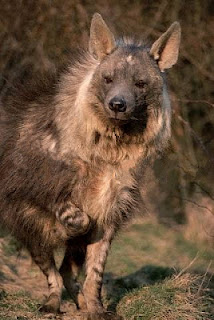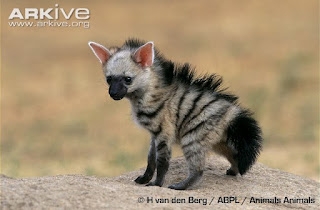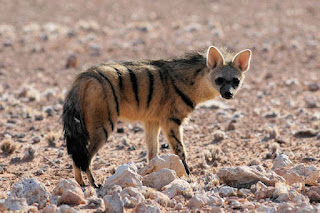The family Hyaenidae consists of four species, including the Striped Hyena, the Brown Hyena, the Spotted Hyena, and the Aardwolf. In general terms, hyenas are cunning, resourceful, bear-like animals with long forelimbs, high shoulders and short hind legs, and a very sturdy, thick build. The striped hyena is one of the smaller members of the Hyaenidae family. It is native to North and East Africa, the Caucasus, the Middle East, Middle and Central Asia, and the Indian Subcontinent. Adult weight ranges from 50-120 pounds, with the average weight being about 77 pounds. It is primarily a scavenger, although the larger specimens have been known to make their own kills. It is a monogamous animal, meaning that both males and females assist in raising cubs. Striped hyenas typically live in groups of 1-2 animals, and are not very territorial. It a completely nocturnal, with very strong eyesight but weak senses of smell and hearing. Its skull is smaller and less massive than the other members of the Hyaenidae family, but still has very strong jaw muscles giving enough bite-force to splinter a camel's thigh bone. Primarily a scavenger, the striped hyena can eat meat, cartilage, ligaments, bone, and bone marrow. The gray wolf actually is a competitor with the striped hyena in Israel and central Asia. Unfortunately, striped hyenas are typically referenced as symbols of treachery and stupidity in Middle Eastern literature and folklore. Despite this reputation, the striped hyena is easily tamed and can be fully trained, capable of becoming as affectionate as well-trained dogs.
 |
| Striped Hyena |
 |
| Brown Hyena |
 |
| Young Brown Hyena |
 |
| Aardwolf pup |
 |
| Aardwolf |
The spotted hyena, also known as the laughing hyena or the tiger wolf, is a species of hyena native to Sub-Saharan Africa. It is common in Kruger National Park, so hopefully there is a good chance that I'll get to see one in the wild! The spotted hyena is the largest member of the family Hyaenidae, with a more bear-like build and less prominent mane than its relatives. The average weight of the spotted hyena tends to be around 150 pounds, although heavier weights of up to 190 pounds have been recorded. Their fur color varies greatly and even changes with age. Their spots can be reddish, deep brown, or blackish and may vary is size. A set of five pale bands replace the spots on the back and sides of the neck. What really sets them apart from their hyena relatives is the fact that the female spotted hyena lacks an external vaginal opening and has a pseudo-penis instead.
To quote my brother, how did evolution come up with that? I don't know. Maybe I'll find out here in a little bit. Perhaps it has something to do with the fact that females dominate males, with even the lowest ranking females being dominant over the highest ranking males. Spotted hyenas live in nepotistic clans of up to 80 animals, where the offspring of dominant females automatically outrank adult females subordinate to their mother. The spotted hyena society is more complex than those of other carnivorous mammals, being more similar to cercopithecine (old world) primates in respect to group size, structure, competition and cooperation. Like old world primates, dominance ranks in hyena societies are not correlated with size or aggression, but with ally networks. The spotted hyena actually acquire rank through coalitions, and it is conscious that some clan-mates may be more reliable than others. When it comes to relationships, females are promiscuous. As you could probably imagine, the mating process is complicated because the female's reproductive tract is entered and exited through her pseudo-penis rather than through her vagina, which is blocked by a false scrotum and testes. I'm not making this up, I swear. Another unique trait of the spotted hyena is the fact that the cubs are born with their eyes open and their teeth in place, and will attack each other shortly after birth.
Spotted hyenas are most carnivorous members of the Hyaenidae, and are both scavengers and hunters. They can splinter, eat and even completely digest the largest of ungulate bones. They most often prey upon wildebeest, followed by zebra and Thompson's gazelle.
Studies strongly suggest convergent evolution in spotted hyena and primate intelligence. Spotted hyenas have outperformed chimpanzees on cooperative problem-solving tests. In one test, captive pairs of spotted hyenas were challenged to tug two ropes in unison to earn a food reward, successfully cooperating and learning the maneuvers without prior training. Experienced hyenas then helped inexperienced clan-mates to solve the problem. The chimps and other primates required extensive training and had a hard time cooperating. Maybe the hyenas are more than just slobbery, mangy, stupid poachers...
The spotted hyena's vocalizations are the famous maniacal laugh sounds.
 |
| Spotted Hyena Cubs |
 |
| Spotted Hyena |
Spotted hyenas have been known to chase off cheetahs from their kills. In this video, you get to see an unusually large coalition of four male cheetahs hunting an Eland. Also, you get to see how powerful hyenas are, and how fragile the cheetahs are.
No comments:
Post a Comment